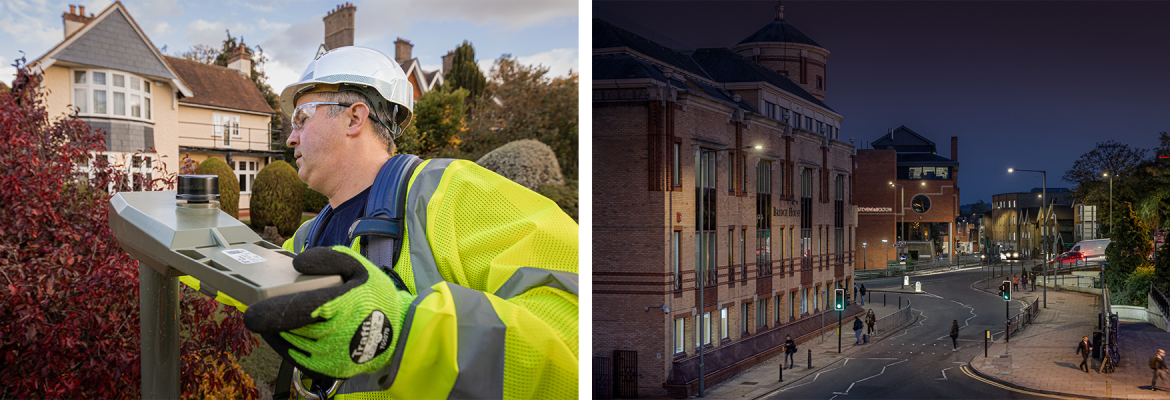Eyes On... Urban Control
February 2023
DW Windsor operates internationally. For the best experience in your region, please select the region most applicable to you.
February 2023
IN THE PRESS
Urban Control is DW Windsor's intelligent solutions brand. In this article, which first appeared in A1 Lighting Magazine's February 2023 issue, we discuss the benefits of smart lighting controls and explain how our new Cellular Node® differs from other lighting control nodes.
Please tell us about Urban Control and its areas of expertise.
Urban Control specialises in creating intelligent, connected spaces through the use of advanced technology. We use sensors and real-time data to improve the living environment, making key aspects of society measurable and controllable. From adaptable streetlighting to smart rail stations, we offer software, hardware and network capabilities to develop scalable solutions that enhance the urban world.
You recently launched your Cellular Node. How does this differ from other lighting control nodes?
Unlike traditional lighting control systems that require specialised networks to be built, our Cellular Node works straight out of the box, just like a mobile phone. This makes it a cost-effective solution for deployments of any size – from one to one million streetlights – enabling the rapid introduction of streetlight controls over a wide area.

A1 Lighting Magazine's February 2023 issue featuring Urban Control
While traditional wireless lighting networks require gateways or access points and extensive network planning, we can deploy any number of nodes in any location by utilising the latest cellular 4G and 5G IoT technologies. Furthermore, our Cellular Node accommodates both NB-IoT and LTE-M standards. This allows it to connect to existing telecoms networks anywhere in the country or worldwide, providing highways agencies and local authorities instant control of their street lighting networks.
A significant advantage of this technology is that it has more reach and penetration than current mesh networking solutions. As a result, it can be deployed across isolated areas, such as car parks, business parks, and retail estates. It also makes it the ideal solution for rural locations, such as villages, where streetlights may be spread far apart.
Lastly, the node is ‘plug and play’, which means that when first powered up, it can determine everything from LED power and wattage to drive current and the unit’s GPS coordinates. All this information is sent directly to the Central Management Software (CMS), which can then be integrated with any third-party asset management system without human interaction, reducing the potential for data errors.

We’re facing an energy crisis; how can smart lighting controls help save energy and lower operating costs?
The global energy crisis is increasingly pushing businesses and local authorities to search for ways to decrease their power bills, with public lighting presenting an opportunity for significant energy savings. To date, around 4m streetlights in the UK have been converted to energy-efficient LEDs. However, according to a recent report, only around a quarter utilise any form of smart control.
Cellular Node is unique because it can be deployed without gateways or access points to target areas where smart controls can have the most impact
Intelligent lighting controls can unlock and deliver all the benefits of LED street lighting networks, including the ability to dynamically control brightness and, thus, energy consumption based on local conditions. This includes responding to sudden changes in pedestrian numbers or road traffic, monitoring energy consumption in real-time, and identifying and pre-empting faults, allowing for the precise planning of maintenance crews.
Cellular Node is unique because it can be deployed without gateways or access points to target areas where smart controls can have the most impact without the considerable capital investment typically associated with CMS.
All of this will have an impact on the electrical energy consumed by the lighting asset, as well as the carbon produced for and associated with the operational nature of the lights. And while a switch to LED technology can deliver savings of 50-70%, the implementation of smart lighting controls could see this increase to over 90% in some circumstances.
But it’s not just the financial incentives that should motivate councils and other bodies to adopt intelligent lighting controls; there are social and environmental benefits too. By incorporating motion sensors, cameras, and real-time monitoring, adaptive street lighting can increase the feeling of safety in public areas. Furthermore, smart lighting controls can help to preserve the natural darkness, which is vital for many species and ecosystems.

Cellular Node uses the Zhaga standard; what are the benefits of this?
All street lighting controls, regardless of their shape, size, or communication protocol, must interface with a luminaire to function. For controls mounted externally, historically, this would have been via a 3-pin NEMA socket which is based on a North American standard. However, as technology has advanced, the number of pins needed to operate has increased to 5 or 7, meaning that modern, smart controllers will not fully function if retrofitted onto luminaires with older sockets.
The Zhaga Consortium is an international organisation set up to resolve these types of issues. Its goal is to standardise the interface between LED luminaire components. As a result, the adoption of Zhaga-approved components has grown significantly as the industry recognises their advantages.
Cellular Node uses the Zhaga Book 18 socket. This offers flexibility and interchangeability while maintaining a standardised format, allowing luminaires installed today to adapt to the technologies of tomorrow. Not only does this future-proof the luminaires, but it also has considerable implications for sustainability and the circular economy.
By using the Zhaga socket, we’re able to keep luminaires in service for longer, helping to reduce waste. In addition, Zhaga-based controllers typically use around 65% less energy than their NEMA equivalents, offering substantial savings across a typical authority, both financially and in terms of energy reduction. Finally, Zhaga offers increased interoperability, particularly when paired with the Cellular Node.
What does Urban Control have planned for 2023?
Since Urban Control was formed in 2015, we’ve seen demand for our intelligent lighting solutions grow significantly, both here in the UK and abroad. Recognising this, in 2023, we plan to expand operations at our Innovation Centre in Portugal to better serve clients in Europe and beyond. At the same time, we’ve set up Urban Control UK to assist our customers here in the UK. By splitting the business across these two locations and working with a network of carefully selected partners, we can support global projects at a local scale.